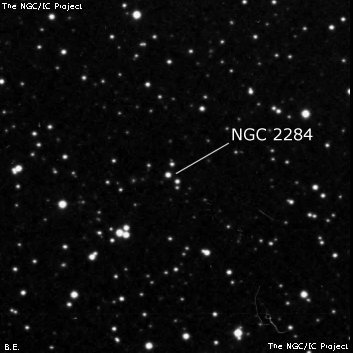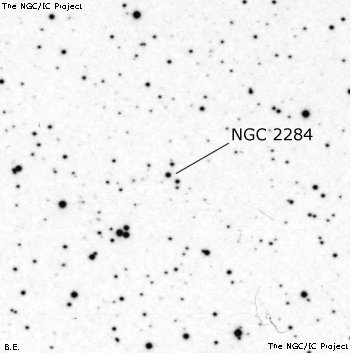NGC/IC Project Restoration Effort
(This is a very very beta version)
NGC2284


Basic Information
Location and Magnitude
Right Ascension: 6:49:9.5
Declination: +33:11:40
Constellation: GEM
Visual Magnitude:
Historic Information
Discoverer: d'Arrest
Year of discovery: 1865
Discovery aperture: 11.0
Observational
Summary description: F, r
Sub-type: *4
Corwin's Notes
=====
NGC 2284 may be an asterism, perhaps comprised of the four stars noted in the
table, but it could be the triple 2 arcminutes southeast. There is nothing
obvious at all around d'A's position, and his descriptions are not very
helpful, either. In his big monograph, he says only, "Neb admodum delicata.
Dissolvitur (amplificatio = 148). Alia subinde, septentrionem versus;
enumerantur primum cum nonnullis aliis in Actis Astronom. [AN] num 1537."
Roughly translated, this reads, "Nebula is faint. Another [one?], towards the
north; [these] are listed for the first time with a few others in AN 1537."
Checking the AN paper, we find the same position and the summary description
"vF. vS. Resolv. pow. 148." D'A has seven new objects listed here; I presume
that the one to the north is NGC 2285 (which see). However, unlike N2285
-- which has a star close to d'A's position -- this entry has no corresponding
stars or nebulae nearby.
Finally, I note that d'A found it on the same night as he found NGC 2277 and
NGC 2285 (both of which see) in the area between the NGC 2274 group and the
NGC 2290 group. Some of his positions here are pretty good, others are not.
I'll do some more work on the area to try to sort it out. LdR and Bigourdan
went over it, too, before the NGC was published. Dreyer is not sure about two
objects here that WH found. JH apparently saw only the nebulae found by his
father.
Steve's Notes
=====
NGC 2284
24" (1/22/15): this number applies to one of two possible triples. At 200x, I found a mag 13.8 star with a mag 14.5 star 19" SW and a mag 15-15.5 star 19" N. The stars were widely split with no hint of appearing nebulous. A fourth mag 16-16.5 star listed in Corwin's table was not seen viewing through thin clouds.
Just 2' SE of these stars is a very nice equilateral triple! The three stars range from mag 12.3-13.5 with sides of 10", 12" and 13". These were also easily resolved.



